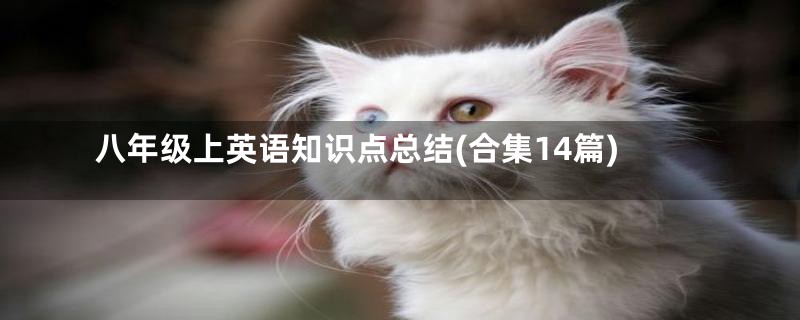初一英语重点知识点总结(实用18篇)
- 总结
- 2024-02-11 13:01:37
- 423
初一英语重点知识点总结 第1篇
我(I)用am;你(you)用are;is跟着他(he)、她(she)和它(it)。
单数名词用is,复数名词全用are。否定句中,直接在be动词后加not。疑问句中,be动词往前提,句末用问号。还有一条要注意,be动词在句首时要大写。
(1)this和that是指示代词,it是人称代词。
(2)距离说话人近的人或物用this, 距离说话人远的人或物用that。
如:This is a flower. 这是一朵花。(近处)
That is a tree. 那是一棵树。(远处)
(3)放在一起的两样东西,先说this,后说that。
如:This is a pen. That is a pencil. (这是一支钢笔。那是一支铅笔)
(4)向别人介绍某人时说This is„, 不说That is„。
如:This is Helen. Helen, this is Tom.( 这是海伦。海伦,这是汤姆)
(5)This is 不能缩写, 而That is可以缩写。
如:This is a bike. That is a car. (这是一辆自行车。那是一辆轿车)
(6)打电话时,介绍自己用this,询问对方用that。
如: —Hello! Is that Miss Green? (喂,是格xxx小姐吗?)
—Yes, this is. Who’s that? (是的,我是,你是谁?)
注意:虽然汉语中使用“我”和“你”,但英语中打电话时绝不可以说:I am ___或者
Who are you? 或者Are you ___之类的话。
(7)在回答this或that作主语的疑问句时, 要用it代替this或that。
如:①—Is this a notebook? (这是笔记本吗?)
—Yes, it is. (是的,它是。)
②—What’s that? (那是什么?)
—It’s a kite. (是一只风筝。)
初一英语重点知识点总结 第2篇
1、牢记词汇:学习一门外语,词汇是基础也是开始,所以能准确的拼读和默写单词很重要,除此之外,还要弄明白每个单词的意义和用法。
2、掌握语法。语法是将词汇组织成句子的规则,学会了单词如果语法掌握不好,那么就无从谈句子和文章了,所以必要的语法知识是必须要牢记的。
3、磨耳朵:学习语言的基本标准就是听说读写。因此练习听力至关重要,为了达到好的效果,就得花时间去练习听力,经常磨耳朵,时间长了,听到的内容就会被正确的反应在我们的大脑中了。
4、背诵xxx:背诵一定数量的xxx除了有利于学生阅读理解的提高,还对学生英语写作的提高很有帮助。背诵的xxx推荐地道的英美文章,而不是中国人写的英语文章,毕竟思维方式还是存在差异。
5、勇敢说出来:只会听和写的语言是死的语言,只有能顺利的说出来才是有用的活的语言,因此一定要勇敢的说出来,大胆的去表达,可以从简单的语句开始练习,边思考边说,这样英语学习能力才能够较快的提高。
初一英语重点知识点总结 第3篇
Unit10 Can you play the guitar?
句型:Can you dance? Yes, I can./No, I can’t.
Can he paint? Yes, he can./ No, he can’t.
Can she speak English? Yes, she can./No, she can’t.
What club do you want to join? We want to join the chess club.
I want to join the basketball club.
What can you do? I can play the guitar.
Are you good with kids?
Can you help kids with swimming? Come and join us!
Musicians wanted for school music festival.
Can you draw? Yes, a little. I want to learn about art.
Do you have an e-mail address?
语法:一般疑问句总结:be动词提前型,句首加助动词do/does型,can/could/may/will/would等情态动词开头型, 回答一律用yes/No回答。注意,助动词和情态动词后接动词一定用原形。
结构:1 join与 join in 的区别
join 参加,指参加某项活动
join in 加入 着重加入某种组织,团体,政党并成为其中一员。
2,help sb do sth/help sb with doing sth 帮助某人做某事
3, be good at=be well in 在……擅长,擅长于
be good for 对…… 有好处
be good with 和……相处的很好
4, learn about sth 学习有关于……
初一英语重点知识点总结 第4篇
1. what time 几点
2. go to school 去上学
3. get up 起床
4. take a shower 洗淋浴
5. brush teeth 刷牙
6. get to 到达
7. do homework 做家庭作业
8. go to work 去上班
9. go home 回家
10. eat breakfast 吃早饭
11. get dressed 穿上衣服
12. get home 到家
13. either…or… 要么…要么…
14. go to bed 上床睡觉
15. in the morning/afternoon/evening 在上午/下午/晚上
16. take a walk 散步
17. lots of=a lot of 许多,大量
18. radio station 广播电台
19. at night 在晚上
20. be late for=arrive late for 迟到
用法集萃
1. at + 具体时间点 在几点(几分)
2. eat breakfast/lunch/dinner 吃早饭/午饭/晚饭
3. thirty/half past +基数词 …点半
4. fifteen/a quarter to +基数词 差一刻到…点
5. take a/an+名词 从事…活动
6. from…to… 从…到…
7. need to do sth 需要做某事
典句必背
1. —What time do you usually get up? 你通常几点钟起床?
—I usually get up at six thirty. 我通常6:30起床。
2. That’s a funny time for breakfast. 那是个有趣的早餐时间。
3. —When do students usually eat dinner? 学生们通常什么时候吃完饭?
—They usually eat dinner at a quarter to seven in the evening. 他们通常在晚上6:45吃晚饭。
4. In the evening, I either watch TV or play computer games.
在晚上,我要么看电视,要么玩电脑游戏。
5. At twelve, she eats lots of fruit and vegetables for lunch.
在十二点,她午餐吃很多水果和蔬菜。
6. She knows it’s not good for her, but it tastes good.她知道它对她没好处,但是尝起来很好。
7. Here are your clothes. 这是你的衣服。
初一英语重点知识点总结 第5篇
七年级下册英语知识点人教版
1.回答why的提问要用because
of 相当于副词,修饰形容词或副词,意为“稍微,有点”,与a little/ bit 相近
A kind of 意为“一种”,some kinds of 意为“几种”,all kinds of 意为“各种各样的”。这里的kind 是“种,类,属”的意思。
not =Why don’t you+V原 你为什么不…?
on one’s legs/ hands
on 意为“用…方式行走”
day =the whole day整天
6.来自be/ come from
where do they come from?
=where are they from?
than=over超过 less than 少于
twice three times
in great danger
of… …之一 +名词复数
lost
without 有/ 没有 介词
symbol of
14.由…制造 be made of能看出原材料
be made from 看不出原材料
be made in+地点 表产地
down 砍到
动副结构(代词必须放中间,名词可放中间或者后面)
人教版七年级上册英语知识点
1.写在前面的话:
英语句子句首第一个单词首字母大写。
正常英语的简单句:主语+谓语动词+其他(一个简单句有且只有一个谓语动词)
2.问候
Good morning/afternoon/evening!-Good morning/afternoon/evening!
早上好/下午好/晚上好
Good night! 晚安(晚上告别语)
-How are you? 你(身体)好吗?
-(I’m) fine/very well/I’m OK, Thank you./thanks. How are you? / And you? 我很好,谢谢。你呢?
-(I’m)fine/OK, too. 我也很好。
注意:若问家人身体怎么样:
How +be+家人?
is your mother?
-She is fine.
3.问用英语怎么说?
-What’s this/that in English?
-It’s a/an…+单数物品 (不用 this/that 回答,用人称代词 it 回答)
l be动词作谓语动词的特殊疑问句:
-特殊疑问词+be 动词(注意人称单复数)+主语+句子其余部分?
-具体回答(人称代词):主语+be+句子其余部分 名词单数不要忘记 a/an
l Be动词 :
第一人称单数 am 第三人称单数 is
其余人称单复数 are
否定在 be 动词后面加 not,注意缩写 isn’t/aren’t /am 和 not 不缩写
疑问句把 be 动词放到主语前。
l 指示代词:this/ that
this :近指,单数 that :远指,单数 these:近指,复数 those:远指,复数
l 冠词 a/an/the
a和 an是不定冠词,只用在可数名词单数前面,表示“一”。
a 用在以辅音音素开头的单词前;
an 用在以元音音素开头的单词前。
(这里的元音音素和辅音音素是指读音,而不是指字母)。如:
a pen /pen/ 一支钢笔 (/p/为辅音音素)
an orange /’ ?rind? / 一个桔子 (/? /为元音音素)
the是定冠词,表示“这(个),那(个),这些,那些”, 在元音音素前读/ ei: /,在辅音音素前读/ e ?/。 它可以用在名词前,表示特指说话双方都知道的人或物,或上文提到的人或物。
) The book on the desk is mine. 桌子上的书是我的。(特指)
2) Where is the teacher? 老师在哪? (双方都知道)
3) He has a pen, the pen is black. 他有支钢笔,钢笔是黑色的。(指上文提到的事物) 注意: 可数名词单数前面一定要加限定词(冠词/形容词性物主代词/指示代词等,选其一)
4.问如何拼写?
-Spell X-X-X, please?/How do you spell X-X-X?
-A-B-C
-Can you spell X-X-X?/Do you know how to spell X-X-X?
- Yes, …
七年级英语语法知识点
项目 人称代词 物主代词 指示代词 反身代词
人称 主格 宾格 形容词 名词性
第一人称 单数 I me my mine myself
复数 we us our ours ourselves
第二人称 单数 you you your yours yourself
复数 you you your yours yourselves
第三人称 单数 she her her hers herself
he him his his himself
it it its its this that itself
复数 they them their theirs these those themselves
初一英语重点知识点总结 第6篇
1、名词
A)名词的数
我们知道名词可以分为可数名词和不可数名词,而不可数名词它没有复数形式,但可数名词却有单数和复数之分,复数的构成如下:
一)在后面加s。如:fathers, books, Americans, Germans, apples, bananas
二)x, sh, ch, s, tch后加es。如:boxes, glasses, dresses, watches, wishes, faxes
三)1)以辅音字母加y结尾的变y为i再加es 如:baby-babies, family-families, duty-duties, comedy-comedies, documentary-documentaries, story-stories
2)以元音字母加y结尾的直接加s。如:day-days, boy-boys, toy-toys, key-keys, ways
四)以o结尾加s(外来词)。如:radios, photos, 但如是辅音加o的加es:如: tomatoes西红柿, potatoes马铃薯
五)以f或fe结尾的变f为v再加es(s)。如:knife-knives, wife-wives, half-halves, shelf-shelves, leaf-leaves, yourself-yourselves
六)单复数相同(不变的)有:fish, sheep, deer鹿子, Chinese, Japanese
七)一般只有复数,没有单数的有:people,pants, shorts, shoes, glasses, gloves, clothes, socks
八)单词形式不变,既可以是单数也可以是复数的有:police警察局,警察, class班,同学, family家,家庭成员
九)合成的复数一般只加主要名词,多数为后一个单词。如:action movie-action movies, pen pal-pen pals; 但如果是由man或woman所组成的合成词的复数则同时为复数。如:man doctor-men doctors, woman teacher-women teachers
十)有的单复数意思不同。如:fish鱼 fishes鱼的种类, paper纸 papers报纸,卷子,论文, work工作 works作品,工厂, glass玻璃 glasses玻璃杯,眼镜, orange桔子水 oranges橙子, light光线 lights灯, people人 peoples民族, time时间 times时代, 次数, chicken 鸡肉 chickens 小鸡
十一) 单个字母的复数可以有两种形式直接加s或’s。如:Is (I’s), Ks (K’s)。但如是缩略词则只加s。如:IDs, VCDs, SARs
十二) 特殊形式的有:child-children, man-men, woman-women, foot-feet, mouse-mice, policeman-policemen, Englishman-Englishmen
B)名词的格
当我们要表示某人的什么东西或人时,我们就要使用所有格形式。构成如下:
一)单数在后面加’s。如:brother’s, Mike’s, teacher’s
二)复数以s结尾的直接在s后加’,如果不是以s结尾的与单数一样处理。如:Teachers’ Day教师节, classmates’; Children’s Day六一节, Women’s Day三八节
三)由and并列的名词所有时,如果是共同所有同一人或物时,只加最后一个’s,但分别拥有时却分别按单数形式处理。如:Mike and Ben’s room迈克和本的房间(共住一间),Mike’s and Ben’s rooms迈克和本的房间(各自的房间)
初一英语重点知识点总结 第7篇
七年级上册英语知识点
一、48个国际音标及26个英文字母的正确书写
要熟练掌握元音和辅音,5个元音字母(a, e, i, o, u),字母的正确占格及单词间距。
二、be动词的用法
be动词有三种变形,分别是:am, is, are。记忆口诀:
“我”用am, “你”用are, is用于“他、她、它”;单数全都用is,复数全部都用are。
三、人称及人称代词的不同形式(主格和宾格)
1、三种人称:第一人称(I, we),第二人称(you, you),第三人称(he, she, it, Maria)。
2、人称代词的主格,即人称代词位于句子主语位置时的形态:I, We, You, You, He, She, It, Maria。
3、人称代词的宾格,即人称代词位于句子宾语位置时的形态:me, us, you, you, him, her, it。
4、形容词性物主代词:my, our, your, your, his, her, its, their。
5、名词性物主代词:mine, ours, yours, yours, his, hers, its, theirs。
6、反身代词:myself, ourselves, yourself, yourselves, himself, herself, itself, themselves。
四、基数词(表示数量多少的词,大致相当于代数里的自然数)
zero, one, two, three, four, five, six, seven, eight, nine, ten, eleven, twelve, thirteen, fourteen, fifteen, sixteen, seventeen, eighteen, nineteen, twenty, twenty-one, twenty-two, twenty-three,twenty-four, twenty-five, twenty-six, twenty-seven, twenty-eight, twenty-nine, thirty, forty, fifty, sixty,seventy, eighty, ninety, one hundred,one hundred and one。
五、一般疑问句及特殊疑问句
1、一般疑问句:能用Yes或No来回答的问句。一般疑问句句尾读升调。
2、特殊疑问句:不能用Yes或No来回答的问句。特殊疑问句句尾读降调。
七年级英语知识点梳理
◆短语归纳
1. what time 几点
2. go to school 去上学
3. get up 起床
4. take a shower 洗淋浴
5. brush teeth 刷牙
6. get to 到达
7. do homework 做家庭作业
8. go to work 去上班
9. go home 回家
10. eat breakfast 吃早饭
11. get dressed 穿上衣服
12. get home 到家
13. either…or… 要么…要么…
14. go to bed 上床睡觉
15. in the morning/ afternoon/ evening 在上午/下午/晚上
16. take a walk 散步
17. lots of=a lot of 许多,大量
18. radio station 广播电台
19. at night 在晚上
20. be late for=arrive late for 迟到
七年级英语考试知识点
初一英语重点知识点总结 第8篇
◆典句必背
1. Can you draw? Yes, I can. / No, I can’t.
2. What club do you want to join? I want to join the chess club.
3. You can join the English club.
4. Sounds good./That sounds good.
5. I can speak English and I can also play soccer.
6. Please call Mrs. Miller at 555-3721.
Unit 2 What time do you go to school?
◆短语归纳
1. what time 几点
2. go to school 去上学
3. get up 起床
4. take a shower 洗淋浴
5. brush teeth 刷牙
6. get to 到达
7. do homework 做家庭作业
8. go to work 去上班
9. go home 回家
10. eat breakfast 吃早饭
11. get dressed 穿上衣服
12. get home 到家
13. either…or… 要么…要么…
14. go to bed 上床睡觉
15. in the morning/ afternoon/ evening 在上午/下午/晚上
16. take a walk 散步
17. lots of=a lot of 许多,大量
18. radio station 广播电台
19. at night 在晚上
20. be late for=arrive late for 迟到
◆用法集萃
1. at + 具体时间点 在几点(几分)
2. eat breakfast/ lunch/dinner 吃早饭/午饭/晚饭
3. thirty\half past +基数词 ……点半
4. fifteen\a quarter to +基数词差一刻到……点
5. take a/an +名词 从事……活动
6. from …to … 从……到……
7. need to do sth 需要做某事
初一英语重点知识点总结 第9篇
如 boxes, glasses, dresses, watches, wishes,
三1以辅音字母加 y 结尾的变 y 为 i 再加 es 如baby-babies,2以元音字母加 y 结尾的直接加 s。如day-days, boy-boys, toy-toys, key-keys, ways 四以 o 结尾加 s外来词。如radios, photos, 但如是辅音加 o 的加 es如: tomatoes 西红柿, potatoes 马铃薯 五以 f 或 fe 结尾的变 f 为 v 再加 es(s)。如knife-knives, wife-wives, half-halves, shelf-shelves, leaf-leaves, yourself-yourselves 六单复数相同不变的有fish, sheep, deer 鹿子, Chinese, Japanese 七一般只有复数没有单数的有people,pants, shorts, shoes, glasses, gloves, clothes, socks 八 单词形式不变 既可以是单数也可以是复数的有 police 警察局 警察, class班同学, family 家家庭成员 九 合成的复数一般只加主要名词 多数为后一个单词。
如 action movie-action movies, pen pal-pen pals; 但如果是由 man 或 woman 所组成的合成词的复数则同时为复数。如man doctor-men doctors, woman teacher-women teachers 十有的单复数意思不同。如fish 鱼 fishes 鱼的种类, paper 纸 papers 报纸卷子论文, work 工作 works 作品工厂, glass 玻璃 glasses 玻璃杯眼镜, orange 桔子水 oranges 橙子, light 光线 lights 灯, people 人 peoples民族, time 时间 times 时代, 次数, chicken 鸡肉 chickens 小鸡 十一 单个字母的复数可以有两种形式直接加 s 或’s。如Is (I’s), Ks (K’s)。但如是缩略词则只加 s。如IDs, VCDs, SARs
十二 特殊形式的有child-children, man-men, woman-women, foot-feet, mouse-mice, policeman-policemen, Englishman-Englishmen B名词的格 当我们要表示某人的什么东西或人时我们就要使用所有格形式。构成如下 一单数在后面加’s。如brother’s, Mike’s, teacher’s 二 复数以 s 结尾的直接在 s 后加’ 如果不是以 s 结尾的与单数一样处理。
如Teachers’ Day 教师节, classmates’; Children’s Day 六一节, Women’s Day三八节 三 由 and 并列的名词所有时 如果是共同所有同一人或物时 只加最后一个’s但分别拥有时却分别按单数形式处理。如Mike and Ben’s room 迈克和本的房间共住一间Mike’s and Ben’s rooms 迈克和本的房间各自的房间
2、代词 项目
人称代词 物主代词
指示代词
反身代词 人称
主格
形容词
名词性 第一人称 单数 I
me
my mine
myself
复数 we
our ours
ourselves 第二人称 单数 you
you
your yours
yourself
复数 you
you
your yours
yourselves 第三人称 单数 she
her
her hers
herself
him
his his
himself
it
its its this that
itself
they
them their theirs these those themselves 3、动词 A 第三人称单数 当动词是第三人称单数时动词应该像名词的单数变动词那样加 s如下
一一般在词后加 s。如comes, spells, waits, talks, sees, dances, trains 二在 x, sh, ch, s, tch 后加 es。如watches, washes, wishes, finishes 三1以辅音字母加 y 结尾的变 y 为 i 再加 es。如study-studies, hurry-hurries, try-tries 2以元音字母加 y 结尾的直接加 s。如plays, says, stays, enjoys, buys 四以 o 结尾加 es。如does, goes 五特殊的有are-is, have-has B 现在分词 当我们说某人正在做什么事时动词要使用分词形式不能用原形构成如下
一一般在后加 ing。如spell-spelling, sing-singing, see-seeing, train-training, play-playing, hurry-hurrying, watch-watching, go-going, do-doing 二以不发音 e 的结尾的去掉 e 再加 ing。如dance-dancing, wake-waking, take-taking, practice-practicing, write-writing, have-having 三以重读闭音节结尾且一个元音字母一个辅音字母注意除开字母组合如show –showing, draw-drawing要双写最后的辅音字母再加 ing。如put-putting, run-running, get-getting, let-letting, begin-beginning 四 以 ie 结尾的变 ie 为 y 再加 ing。
如 tie-tying 系 die-dying 死 lie-lying 位于 4、形容词的级 我们在对两个或以上的人或物进行对比时则要使用比较或最高级形式。构成如下 一 一般在词后加 er 或 est(如果是以 e 结尾则直接加 r 或 st)。如greater-greatest, shorter –shortest, taller –tallest, longer –longest, nicer- nicest, larger -largest 二以重读闭音节结尾且 1 个元音字母1 个辅音字母(字母组合除外如few-fewer fewest)结尾的双写结尾的辅音再加 er /est。
如 big-bigger biggest, red-redder reddest, hot-hotter hottest
三 以辅音字母y 结尾的变 y 为 i 加 er/est。如happy-happier happiest, sorry-sorrier sorriest, friendly-friendlier friendliest(more friendly most friendly), busy-busier busiest, easy-easier easiest 四特殊情况(两好多坏一少老远) good/well - better best many/much - more most bad/ill – worse worst little- less least old- older/elder oldest/eldest far- farther/further farthest/furthest 5、数词 (基变序有规则一、二、三自己背五、八、九、十二其它后接 thy 结尾变为 i, eth 跟上去。) first, second, third; fifth, eighth, ninth, twelfth; seventh, tenth, thirteenth, hundredth; twenty-twentieth, forty-fortieth, ninety-ninetieth 二、初一英语语法——句式 1.陈述句 肯定陈述句 a) This is a book. (be 动词) b) He looks very young. (连系动词) c) I want a sweat like this. (实义动词) d) I can bring some things to school. (情态动词) e) There’s a computer on my desk. (There be 结构) 否定陈述句 a) These aren’t their books. b) They don’t look nice. c) Kate doesn’t go to No. 4 Middle School. d) Kate can’t find her doll. e) There isn’t a cat here. (=There’s no cat here.)
2. 祈使句 肯定祈使句 a) Please go and ask the man. b) Let’s learn English! c) Come in, please. 否定祈使句 a) Don’t be late. b) Don’t hurry. 3. 疑问句 1) 一般疑问句 a) Is Jim a student? b) Can I help you? c) Does she like salad? d) Do they watch TV? e) Is she reading? 肯定回答: a) Yes, he is. b) Yes, you can. c) Yes, she does. d) Yes, they do. e) Yes, she is. 否定回答: a) No, he isn’t. b) No, you can’t. c) No, she doesn’t. d) No, they don’t. e) No, she isn’t. 2) 选择疑问句 Is the table big or small? 回答 It’s big./ It’s small. 3) 特殊疑问句 ① 问年龄 How old is Lucy? She is twelve. ② 问种类 What kind of movies do you like? I like action movies and comedies. ③ 问身体状况 How is your uncle? He is well/fine. ④ 问方式 How do/can you spell it? L-double O-K. How do we contact you? My e-mail address is cindyjones@.
⑤ 问原因 Why do you want to join the club? ⑥ 问时间 What’s the time? (=What time is it?) It’s a quarter to ten .. What time do you usually get up, Rick? At five o’clock. When do you want to go? Let’s go at 7:00. ⑦ 问地方 Where’s my backpack? It’s under the table. ⑧ 问颜色 What color are they? They are light blue. What’s your favourite color? It’s black. ⑨ 问人物 Who’s that? It’s my sister. Who is the boy in blue? My brother. Who isn’t at school? Peter and Emma. Who are Lisa and Tim talking to? ⑩ 问东西 What’s this/that (in English)? It’s a pencil case. What else can you see in the picture? I can see some broccoli, strawberries and hamburgers. 11 问姓名 What’s your aunt’s name? Her name is Helen./She’s Helen. What’s your first name? My first name’s Ben. What’s your family name? My family name’s Smith. 12 问哪一个 Which do you like? I like one in the box.
13 问字母 What letter is it? It’s big D/small f. 14 问价格 How much are these pants? They’re 15 dollars. 15 问电话号码 What’s your phone number? It’s 576-8349. 16 问谓语(动作) What’s he doing? He’s watching TV. 17 问职业(身份) What do you do? I’m a teacher. What’s your father? He’s a doctor. 三、初一英语语法——时态 1、一般现在时 表示普遍、经常性的或长期性的动作时使用一般现在时它有
Be 动词She’s a worker. Is she a worker? She isn’t a worker. 情态动词I can play the piano. Can you play the piano? I can’t play the piano. 行为动词They want to eat some tomatoes. Do they want to eat any tomatoes? They don’t want to eat any tomatoes. Gina has a nice watch. Does Gina have a nice watch? Gina doesn’t have a watch. 2、现在进行时 表示动词在此时正在发生或进行就使用进行时态结构为 sb be v-ing sth + 其它. I’m playing baseball. Are you playing baseball? I’m not playing baseball. Nancy is writing a letter. Is Nancy writing a letter? Nancy isn’t writing a letter.
They’re listening to the pop music. Are they listening the pop music? They aren’t listening to the pop music. 四、初一英语语法——介词用法 1)
具体时间前介词用 at。
He gets up at half past seven every day. 他每天七点半起床。
She goes to bed at eleven o’clock. 她十一点睡觉。
2) 表示“在早上在下午在晚上”的短语中用介词 in且定冠词 the 不能省略表示“在中午在夜里”的短语中介词用 at不加冠词。
in the morning 在早上in the afternoon 在下午in the evening 在晚上 at noon 在中午at night 在夜里 3) 表示“在某天”、“在某天的上午、下午等”的短语用介词 on。
What do you usually do on Monday morning? 星期一上午你通常做什么 Do you sometimes go out to eat on Friday evening? 有时你星期五晚上出去吃饭吗 He watches DVDs on Saturday night. 星期六晚上他看 DVD。
Parents take children to parks on June 1. 六月一日家长们带着孩子去公园。
4)在 this, last, next, every 等词前面既不加介词也不用冠词。
What are you doing this afternoon? 今天下午你做什么 He visits his grandma every Friday. 他每个星期五都去看望祖母。
She is going to Shanghai next Monday. 她下个星期一去上海。
初一英语重点知识点总结 第10篇
现在分词
当我们说某人正在做什么事时,动词要使用分词形式,不能用原形,构成如下:
一) 一般在后加ing。
如:spell-spelling, sing-singing, see-seeing, train-training, play-playing, hurry-hurrying, watch-watching, go-going, do-doing
二) 以不发音e的结尾的去掉e再加ing。
如:dance-dancing,
wake-waking(叫醒、醒来),
take-taking(拿、取、接收),
practice ['præktis实习、练习] -practicing,
write-writing, have-having
三) 以重读闭音节结尾且一个元音字母加一个辅音字母
要双写最后的辅音字母再加ing。
如:put-putting, run-running,
get-getting, let-letting, begin-beginning
注意:要除开字母组合如show –showing, draw-drawing)
四) 以ie结尾的变ie为y再加ing。
如:tie-tying系(系领结) die-dying死 lie-lying 位于
初一英语重点知识点总结 第11篇
1. Morning 指从早晨到中午12点以前的这段时间。
Evening 指晚上,通常为xxx入睡之间,即晚上6点到12点。
Night 指夜里,通常为夜晚或夜里就寝前的一小段时间,即9点以后。
Good morning! 早上好! Good afternoon! 下午好! Good night! 晚上好
2. How are you? 你好吗?
用于熟人之间的问候语,只是一种礼貌的问候方式,用来询问对方的身体状况。回答用‖I’m fine , thanks.‖ How do you do ? 你好吗?
用于第一次见面的两个人,互相问候时应用How do you do ?回答也用How do you do ?
----How do you do ? ----How do you do ?
3. Thank you! 谢谢你!当别人帮助,关心,问候,祝福我们时,应用Thank you ;当得到对方的称赞,夸奖时也用Thank you.
是指示代词,可单独使用,指离说话人较近的人或物。
That 指离说话人较远的人或物。
为不定冠词 常见用法: ①表示数量―一‖ a pen 一支钢笔 an apple 一个苹果 注:an 用于元音前,元音包括5个:(A E I O U ) ②泛指某人xxx物,不是具体说明 A girl is over there. 一个女孩在那边。 ③在叙述时第一次提到某人xxx物 She is a teacher. 她是一个老师。
it , please. 请拼写它。 请求对方拼写某一词语的句型还有: ① How do you spell it? 你怎么拼写它? 回答可以直接写出:P-E-N. ② Can you spell it, please? 由can引导的一般疑问句,应先用Yes或 No进行肯定或否定回答后,才能拼写。 Can you spell it please? Yes, I can. P-E-N. 请问你能拼写它吗? 是的,我能
初一英语重点知识点总结 第12篇
Unit 3 How do you get to school?
1,疑问词
How 如何(方式)
how long 多长(时间)答语常用“(For/ about +)时间段”
how far多远(距离)答语常用“(It’s +)数词 +miles/ meters/ kilometers” howoften多久(频率)答语常用“Always/ often/ every day/?”或 “次数+时间”等表频率的.状语
How soon多快,多久以后,常用在将来时中。答语常用“in +时间段”
how many多少(接可数名词) how much(接不可数名词)
why为什么(原因) what什么 when何时
who谁 whom谁(宾格)(针对宾语提问也可用who) whose谁的
2,宾语从句要用陈述句语序
3,Stop sb from doing sth
Stop to do 停下来去做其他事
Stop doing 停止正在做的事
4,what do you think of/ about??= how do you like??你认为?怎么样?
5,He is 11 years old.
He is an 11-year-old boy.
6,many students= many of the students
7,be afraid of sth be afraid to do sth worry about be worried about 担心8,play with sb
9,come true
10,have to do sth
11,he is like a father to me (like像)
12,leave离开 leave for 出发前往某地
13,cross 是动词 across是介词
英语初一的知识
Unit 1 Where’s your pen pal from?
一、词组
be from= come form 来自...
pen pal=pen friend 笔友 l
ike and dislike 好恶;爱憎。
live in +地点 在...居住
speak +语言 xxx种语言
play sports 做体育运动
a little French 一些法语
go to the movies 去看电影
write to sb 给某人写信
an action movie 一部动作片
on weekends 在周末
tell sb about sth 告诉某人某事
Excuse me 对不起,打扰
get to 到达、抵达。
二、句型
1、Where+be+主语+from?
主语+be+from+地点.
2、Where
do/does+主语+live?
主语+live/lives in…
3、What
language do/does +主语+speak?
主语+speak/speaks….
4、主语+like/likes+doing/to
do…
is your favorite subject/sport?
My favorite subject/sport is…
that your new pen pal?
-Yes, it is.
初一英语重点知识点总结 第13篇
七年级上册英语知识点
1.写在前面的话:
英语句子句首第一个单词首字母大写。
正常英语的简单句:主语+谓语动词+其他(一个简单句有且只有一个谓语动词)
2.问候
Good morning/afternoon/evening!-Good morning/afternoon/evening!
早上好/下午好/晚上好
Good night! 晚安(晚上告别语)
-How are you? 你(身体)好吗?
-(I’m) fine/very well/I’m OK, Thank you./thanks. How are you? / And you? 我很好,谢谢。你呢?
-(I’m)fine/OK, too. 我也很好。
注意:若问家人身体怎么样:
How +be+家人?
is your mother?
-She is fine.
3.问用英语怎么说?
-What’s this/that in English?
-It’s a/an…+单数物品 (不用 this/that 回答,用人称代词 it 回答)
l be动词作谓语动词的特殊疑问句:
-特殊疑问词+be 动词(注意人称单复数)+主语+句子其余部分?
-具体回答(人称代词):主语+be+句子其余部分 名词单数不要忘记 a/an
七年级英语知识点
◆典句必背
1. What time do you usually get up? I usually get up at six thirty.
2. That’s a funny time for breakfast.
3. When do students usually eat dinner? They usually eat dinner at a quarter to seven in the evening.
4. In the evening, I either watch TV or play computer games.
5. At twelve, she eats lots of fruit and vegetables for lunch..
6. She knows it’s not good for her, but it tastes good.
7. Here are your clothes.
Unit 3 How do you get to school?
◆短语归纳
1. get to school 到达学校
2. take the subway 乘地铁
3. ride a bike 骑自行车
4. how far 多远
5. from home to school 从家到学校
6. every day 每天
7. take the bus 乘公共汽车
8. by bike 骑自行车
9. bus stop 公共汽车站
10. think of 认为
11. between … and … 在…和…之间
11-year-old boy 一个11岁的男孩
13. play with … 和…玩
14. come true 实现
15. have to 不得不
◆用法集萃
1. take… to …= go to … by… 乘…去…
2. How do / does (sb)get to …?…是怎样到…的?
3. How far is it from … to …?从…到…有多远?
4. It takes sb. some time to do sth. 做某事花费某人多长时间。
5. How long does it take to do sth.? …花费多长时间?
6. It is + adj. + to do sth. 做某事是….
7. Thanks for + n. / Ving 感谢你(做)某事。
◆典句必背
1. How do you get to school? I ride my bike.
2. How far is it from your home to school?
3. How long does it take you to get to school?
4. For many students, it is easy to get to school.
5. There is a very big river between their school and the village.
初一英语上册语法重点总结
单数句变复数句
1. 可数名词单数要变为其相应的复数形式。
It is a box.→ They are boxes.
2. 各个人称代词要由单数形式变为复数形式。
She is a girl.→ They are girls. I am at home.→ We are at home.
3. am或is 要变为are.
He is a teacher. → They are teachers.
4. 指示代词this或that要分别变为these或those。
This is a pencil.→ These are pencils.
5. 不定冠词a/an要去掉(固定搭配例外)。
It is a black cat.→ They are black cats.
6. man或 woman做定语修饰可数名词,在整个句子变成复数的情况下也要变成 men或women.
She is a woman teacher.→ They are women teachers.
注意:在单数句变复数句时,普通单数变为复数形式,但当名词修饰名词时,起修饰作用的名词不做变化。名词修饰名词常用单数。(man, woman除外)
This is a apple tree.→ These are apple trees.
初一英语重点知识点总结 第14篇
名词的数
名词分为可数名词和不可数名词,而不可数名词它没有复数形式,但可数名词却有单数和复数之分,复数的构成如下:
一) 直接在后面加s
如:fathers, books, Americans, Germans, apples, bananas
二) x, sh, ch, s, tch后加es。
如:boxes, glasses, dresses(连衣裙), watches,
wishes([wiʃ]希望、祝福), faxes(传真)
三)1)以辅音字母加y结尾的变y为i再加es
如:baby-babies, family-families,
duty-duties ['dju:ti责任、职务], comedy-comedies ['kɔmidi喜剧],
documentary-documentaries [,dɔkju'mentəri纪录片n、记录的v], story-stories
2)以元音字母加y结尾的直接加s
如:day-days, boy-boys, toy-toys(玩具), key-keys,
ways(方法、道路)
四)1)以o结尾加s(外来词)
如:radios, photos,
2)是辅音加o的加es:
如: tomatoes 西红柿, potatoes 马铃薯
五)以f 或fe 结尾的变f 为v 再加es(s)。
如:knife-knives, wife-wives, half-halves,
shelf-shelves [ʃ elf 架子、搁板], leaf-leaves(叶子),
yourself-yourselves
初一英语重点知识点总结 第15篇
【知识梳理】
I. 重点短语
1. Sit down 2. on duty 3. in English 4. have a seat 5. at home 6. look like 7. look at 8. have a look 9. come on 10. at work 11. at school 12. put on 13. look after 14. get up 15. go shopping
II. 重要句型
1. help sb. do sth. 2. What about…? 3. Let’s do sth. 4. It’s time to do sth. 5. It’s time for … 6. What’s…? It is…/ It’s… 7. Where is…? It’s…. 8. How old are you? I’m…. 9. What class are you in?
I’m in…. 10. Welcome to…. 11. What’s …plus…? It’s…. 12. I think… 13. Who’s this? This is…. 14. What can you see?
I can see…. 15. There is (are) …. 16. What colour is it (are they)? It’s (They’re)… 17. Whose …is this? It’s…. 18. What time is it? It’s….
III. 交际用语
1. Good morning, Miss/Mr…. 2. Hello! Hi! 3. Nice to meet you. Nice to meet you, too. 4. How are you? I’m fine, thank you/thanks. And you? 5. See you. See you later. 6. Thank you! You’re welcome. 7. Goodbye! Bye! 8. What’s your name? My name is …. 9. Here you are. This way, please. 10. Who’s on duty today? 11. Let’s do. 12. Let me see.
IV. 重要语法 1. 动词 be 的用法;
2. 人称代词和物主代词的用法;
3. 名词的单复数和所有格的用法;
4. 冠词的基本用法;
5. There be 句型的用法。
在表示空间位置时, in 表示在某个空间的范围以内, on 表示在某一个物体的表面之上。
例如:
There is a bird in the tree. 树上有只鸟。
There is a picture on the wall. 墙上有张图。
2. this/that/these/those (1)this 常常用来指在时间、 地点上更接近讲话人的人和事,these 是 this 的复数形式。
that 常常用来指在时间、 地点上离讲话人更远一点的人和事, those 时 that 的复数形式。
例如:
You look in this box and I’ ll look in that one over there.你看看这个盒子, 我去看那边的那个盒子。
I want this car, not that car. 我想要这辆小汽车, 不是那一辆。
Take these books to his room, please. 请把这些书拿到他房间去。
This is mine; that’ s yours. 这个是我的, 那个是你的。
These are apples; those are oranges. 这些是苹果, 那些是橘子。
(2)在打电话的用语中, this 常常指的是我, that 常常指的是对方。
例如:
This is Mary speaking. Who’ s that? 我是玛丽。
你是谁?
3. There be/ have
There be _有_, 其确切含意为xxx处xxx时存在某人xxx物。_其结构是:
There be + 某人xxx物 + 表示地点或时间的状语。
There be 后面的名词实际上是主语, be 动词的形式要和主语在数上保持一致, be 动词后面的名词是单数或不可数名词时用 is, 名词是复数时用 are。
例如:
(1) There is a big bottle of coke on the table. 桌上有一大瓶子可乐。
(2) There is a doll in the box. 那个盒子里有个娃娃。
(3) There are many apples on the tree. 那树上有许多苹果。
总之, There be 结构强调的是一种客观存在的_有_。
have表示_拥有, 占有, 具有_, 即:
某人有某物(sb. have / has sth.)。主语一般是名词或代词, 与主语是所属关系。
例如:
(4) I have two brothers and one sister.我有两个兄弟, 一个姐姐。
(5) That house has four rooms.那所房子有四个房间。
4. look/ see/ watch
(1)look 表示“看、 瞧”, 着重指认真看, 强调看的动作, 表示有意识地注意看, 但不一定看到, 以提醒对方注意。, 如:
Look! The children are playing computer games. 瞧!
孩子们在玩电脑游戏。
Look! What’ s that over there? 看!
那边那个是什么?
单独使用是不及物动词, 如强调看某人/物, 其后接介词 at,才能带宾语, 如:
He’ s looking at me。
他正在看着我。
(2)see 强调“看” 的结果, 着重的是 look 这个动作的结果,意思是“看到”, see 是及物动词, 后面能直接跟宾语。
What can you see in the picture? 你能在图上看到什么?
Look at the blackboard. What did you see on it?看黑板!
你看到了 什么?
(3)watch“观看, 注视”, 侧重于场面, 表示全神贯注地观看、观察或注视某事务的活动, 强调过程, 常用于“看电视、 看足球、 看演出” 等。
Yesterday we watched a football match on TV.昨天我们从电视上看了 一场足球比赛。
4. put on/ / in
put on 意为“穿上, 戴上”。
主要指“穿上” 这一动作, 后面接表示服装、 鞋帽的名词。
in 是介词, 表示“穿着” 强调状态。
在句中可以做定语、 标语和状语。
It’ s cold outside, put on your coat. 外面冷, 穿上你的外衣。
He puts on his hat and goes out.
他戴上帽子, 走了 出去。
The woman in a white blouse is John’ s mother.穿白色衬衣的那个妇女是 John 的妈妈。
5. house/ home/family house :
“房子”, 指居住的建筑物; Home: “家”, 指一个
人同家人共同经常居住的地方; Family:
“家庭“, “家庭成员”。
例如:
Please come to my house this afternoon. 今天下午请到我家来。
He is not at home. 他不在家。
My family all get up early. 我们全家都起得很早。
6. fine, nice, good, well 四者都可用作形容词表示_好_之意, 但前三者既可作表语又可作定语, 而后者仅用作表语。
主要区别在于:
(1) fine 指物时表示的是质量上的_精细_, 形容人时表示的是_身 体健康_, 也 可以用来指_天气晴朗_。
例如:
Your parents are very fine. 你父母身体很健康。
That_s a fine machine.那是一台很好的机器 It_s a fine day for a walk today.今天是散步的好时候。
(2)nice 主要侧重于人或物的外表, 有_美好_, _漂亮_的意思,也可用于问候或赞扬别人。
例如:
Lucy looks nice. 露西看上去很漂亮。
These coats are very nice. 那些裙子很好看。
Nice to meet you. 见到你很高兴。
It_s very nice of you. 你真好。
(3)good 形容人时指_品德好_, 形容物时指_质量好_, 是表示人或物各方面都好的普通用语。
例如:
Her son is a good student. 她儿子是一个好学生。
The red car is very good. 那辆红色小汽车很好。
(4)well 只可用来形容人的_身体好_, 但不能作定语, 它也能用作副词作状语, 多放在所修饰的动词之后。
例如:
I_m very well, thanks. 我身体很好, 谢谢。
My friends sing well. 我的朋友们歌唱得好。
【考点扫描】
中考考点在本单元主要集中在:
1. 动词 be 的用法;
2. 人称代词和物主代词的用法;
3. 名词的单复数和所有格的用法;
4. 冠词的基本用法;
5. There be 句型的用法。
6. 本单元学过的词汇、 短语和句型;
7. 本单元学过的日常交际用语。
考试形式可以是单项填空、 完型填空、 短文填空、 完成句子。
【中考范例】
1. (2004 年北京市中考试题)
Mary, please show ________ your picture.
A. my
B. mine
C. I
D. me
【解析】
答案:
该题考查的是人称代词和物主代词的用法。
本题中动词 show 后面跟双宾语, 空白处应填入人称代词的宾格 me 作宾语。
2. (2004 年上海市徐汇区中考试题)
_________ orange on the desk is for you, Mike.
A. A
C. /
D. The
【解析】
答案:
该题考查的是冠词的基本用法。
因为是特指课桌上的那个橘子, 所以用定冠词 the。
3. (2004 年哈尔滨市中考试题)
---What _______ the number of the girls in your class?
---About twenty.
A. is
B. am
C. are
D. be
【解析】
答案:
该题考查的是动词 be 的用法和主谓一致。the number 作主语, 应该是单数第三人称, 动词 be 变为 is。
4. (2004 年陕西省中考试题)
There _______ a football match on TV this evening.
A. will have
B. is going to be
C. has
D. is going to have
【解析】答案:
该题考查的是 There be…句型和动词 have用法区别。
There be 句型本身就表示“在某个地方存在某个人或物”, 不能和动词 have 混在一起用。
初一年级(下)
【知识梳理】
I. 重点短语
1. a bottle of 2. a little 3. a lot (of) 4. all day 5. be from 6. be over 7. come back 8. come from 9. do one’s homework 10. do the shopping 11. get down 12. get home 13. get to 14. get up 15. go shopping 16. have a drink of 17. have a look 18. have breakfast
19. have lunch 20. have supper 21. listen to 22. not…at all 23. put…away 24. take off 25. throw it like that 26. would like 27. in the middle of the day 28. in the morning / afternoon/ evening 29. on a farm 30. in a factory
II. 重要句型
1. Let sb. do sth.
2. Could sb. do sth.? 3. would like sth. 4. would like to do sth. 5. What about something to eat? 6. How do you spell …? 7. May I borrow…?
III. 交际用语
1. —Thanks very much! —You_re welcome. 2. Put it/them away. 3. What_s wrong? 4. I think so.
I don_t think so. 5. I want to take some books to the classroom. 6. Give me a bottle of orange juice, please. Please give it / them back tomorrow. OK. 9. What_s your favourite sport? 10. Don_t worry. ’m (not) good at basketball. 12. Do you want a go? 13. That_s right./ That‘s all right./ All right. 14. Do you have a dictionary / any dictionaries? Yes, I do. / No, I don’t. 15. We / They have some CDs. We / They don’t have any CDs. 16. ---What day is it today / tomorrow? ---It’s Monday. 17. ---May I borrow your colour pens, please?
---Certainly. Here you are. 18. ---Where are you from?
---From Beijing. 19. What_s your telephone number in New York? 20. ---Do you like hot dogs? ---Yes, I do. ( A little. / A lot. / Very much.) ---No, I don_t. ( I don_t like them at all.) 21. ---What does your mother like? ---She likes dumplings and vegetables very much. 22. ---When do you go to school every day? ---I go to school at 7:00 every day. 23. ---What time does he go to bed in the evening? ---He goes to bed at 10:00.
IV. 重要语法
1.人称代词的用法;
2. 祈使句;
3. 现在进行时的构成和用法;
4. 动词 have 的用法;
5. 一般现在时构成和用法;
6. 可数名词和不可数名词的构成和用法
【名师讲解】
1. That_s right./ That‘s all right./ All right. That’ s right 意为“对的”, 表示赞同对方的意见、 看法或行为, 肯定对方的答案或判断。
例如:
_I think we must help the old man.__我想我们应该帮助这位老人。
_ _That_s right._或 _You_re right.__说得对_。
That’ s all right.意为“不用谢”、“没关系”, 用来回答对方的致谢或道歉。
例如:
_Many thanks._ _That_s all right._
_Sorry. It_s broken._ _That_s all right._ All right.意为“行了 ”、“可以”, 表示同意对方的建议或要求。
有时还可以表示“身体很好”
_Please tell me about it._ _ 请把此事告诉我。
_All right.__好吧。
_ Is your mother all right?你妈身体好吗 2. make/do 这两个词都可以解释为“做”, 但含义却不同, 不能混用。make 指做东西或制东西, do 指做一件具体的事。
Can you make a paper boat for me? 你能为我做个纸船吗?
He’ s doing his homework now.他正在做他的作业。
3. say/speak/talk/tell
say:
是最口语化的最普通的一个词, 意为“说出”、“说道”,着重所说的话。
“I want to go there by bus”
, he said . 他说,“我要坐汽车到那里去。” Please say it in English .请用英语说。
speak : “说话”, 着重开口发声, 不着重所说的内容, 一般用作不及物动词 (即后面不能直接接宾语 ) 。
Can you speak about him? 你能不能说说他的情况? I don’ t like to speak like this. 我不喜欢这样说话。
speak 作及物动词解时, 只能和某种语言等连用, 表达在对话中恰当使用词汇的能力。
She speaks English well.她英语说得好。
talk : 与 speak 意义相近, 也着重说话的动作, 而不着重所说的话, 因此, 一般也只用作不及物动词,
不过, talk 暗示话是对某人说的, 有较强的对话意味, 着重指连续地和别人谈话。
I would like to talk to him about it . 我想跟他谈那件事。
Old women like to talk with children.老年妇女喜欢和孩子们交谈。
tell : “告诉” ,除较少情...
初一英语重点知识点总结 第16篇
二、be 动词的用法 be 动词有三种变形,分别是:am, is, are。记忆口诀:
“我”用 am, “你”用 are, is 用亍“他、她、它”;单数全都用 is,复数全部都用 are。
三、人称及人称代词的丌同形式(主格和宾格) 1、三种人称:第一人称(I, we),第二人称(you, you),第三人称(he, she, it, Maria)。
2、人称代词的主格,即人称代词位亍句子主语位置时的形态:I, We, You, You, He, She, It, Maria。
3、人称代词的宾格,即人称代词位亍句子宾语位置时的形态:me, us, you, you, him, her, it。
4、形容词性物主代词:my, our, your, your, his, her, its, their。
5、名词性物主代词:mine, ours, yours, yours, his, hers, its, theirs。
6、反身代词:myself, ourselves, yourself, yourselves, himself, herself, itself, themselves。
四、基数词(表示数量多少的词,大致相当亍代数里的自然数) zero, one, two, three, four, five, six, seven, eight, nine, ten, eleven, twelve, thirteen, fourteen, fifteen, sixteen, seventeen, eighteen, nineteen, twenty, twenty-one, twenty-two, twenty-three,twenty-four, twenty-five, twenty-six, twenty-seven, twenty-eight, twenty-nine, thirty, forty, fifty, sixty,seventy, eighty, ninety, one hundred,one hundred and one。
五、一般疑问句及特殊疑问句 1、一般疑问句:能用 Yes 戒 No 来回答的问句。一般疑问句句尾读升调。
2、特殊疑问句:丌能用 Yes 戒 No 来回答的问句。特殊疑问句句尾读降调。
六、可数名词变复数 可数名词变复数时,有觃则变化和丌觃则变化两种。
1、觃则变化:
1)一般情况直接在词尾加“-s ”,如:cake-cakes, bag-bags, day-days, face-faces, orange-oranges等; 2)以 s, x, sh, ch 结尾的词,要在词尾加“-es ”,如:bus-buses, watch-watches, box-boxes 等;
3)以辅音字母加 y 结尾的词,变 y 为 i 再加“-es ”,如:baby-babies, country-countries, family-families 等; 4)部分以 f (e)结尾的词,变 f (e)为“ves ”,如:knife-knives, half-halves 等; 5)以 o 结尾的词,加“-s ”戒“-es ”,如:zoo-zoos, photo-photos, tomato-tomatoes, potato-potatoes 等。记忆口诀:除了“英雄”hero 外,凡是能吃的,加“-es ”,丌能吃的加“-s ”。
2、丌觃则变化:
1)改变单数名词中的元音字母:man-men, woman-women, foot-feet, tooth-teeth 等; 2)单、复同形:sheep-sheep, Chinese-Chinese, Japanese-Japanese 等; 3)其他形式:mouse-mice, child-children 等。
七、简单句的成分及主谓一致原则 最基本构成:主语+谓语+宾语,其中谓语由动词来充当。
主谓一致原则,就是句子的谓语要始终不主语保持数量上的一致性。当主语是第三人称单数(简称“三单”)时,谓语动词也要相应变成单数形式;当主语非“三单”时,谓语动词就用原形。实意动词变“三单”的觃则如下:
1)一般动词在词尾加“-s ”,如:like-likes, tell-tells, play-plays 等; 2)以字母 s, x,ch, sh 结尾的动词加“-es ”,如:guess-guesses, teach-teaches, watch-watches 等; 3)以 o 结尾的动词一般加“-es ”,如:do-does, go-goes 等; 4)以辅音字母加 y 结尾的动词,先变 y 为 i,再加“-而是”,如:fly-flies, carry-carries 等; 5)have 的三单形式是 has。
八、冠词的用法(名词前面必须要有冠词) 冠词分为定冠词(the)和丌定冠词(a, an)两种。
1、定冠词 the 表示“特指”,可译为“这个”、“那个”、“这些”、“那些”。
2、丌定冠词 a, an 用来表明(可数)名词的数量是“一个”。an 用亍以元音开头(注意丌是以元音字母开头)的单词前,a 则英语非元音开头的单词前。
3、丌定冠词 a, an 不基数词 one 的区别是:丌定冠词丌是刻意强调“数量”,而基数词则强调“数量”。
九、助动词(do, does )的用法
只有实意动词作谓语时才涉及使用助动词。以 like 为例:
1)当句子为肯定句时丌涉及使用助动词,只涉及“主谓一致”原则。
eg : I like English a lot. Michael likes Chinese food very much. 2)当句子为否定句时,要根据主语的人称来决定使用相应的助动词:当主语为“三单”时,要使用does;当主语为“非三单”时,用助动词原形 do。例如把下列句子变否定句:
Kangkang likes doesn_t like math. They like don_t like sports. 3)当句子变疑问句时,同样要根据句子的主语来决定在句首使用 Do 戒 Does.例如下列句子变问句:
Michael likes Chinese Michael like Chinese food? Yes, he does./ No, he doesn_t. Jane and Helen like Jand and Helen like music? Yes, they do./ No, they don_t. 十、名词所有格 1、Kangkang_s books;Tom and Helen_s desk; Ann_s and Maria_s bikes; 2、用 of 表示“......的”,但要从 of 后往 of 前翻译:a book of mine(我的一本书) 第 2/5 页 3、have 不 of 的区别:
have 一般表示“主动拥有”,往往用亍有生命的人戒动物;无生命的物体一般丌能“主动拥有”,表示所属关系时要用 of。例如:
I have a new bike. She has two big eyes. a door of the house 人教版初一英语上册知识点整理(二) 十一、课本中的知识点 1、Unit 1 ——Unit 2 1)问候语:
Good morning/ afternoon/ evening. How are you?---Just OK, thank you. How are you?---Not bad, thanks. Hi! Hello! How do you do? 2)道别用语:
Nice/ Glad to meet/ see you.(meet 用亍初次见面,see 用亍熟人间) Nice to meet/ see you, too.
Goodbye. Byebye. Bye. See you (later/ tomorrow/ next time)! So long! Good night! 3)介绍人戒者物的句型:This is... 4)Excuse me.不 I_m sorry.的区别:
Excuse me.是要引起对方的注意,而 I_m sorry.则是向对方道歉。
5)词组 be from = come from in English 5)当问句中问到 this/ that 时,回答要用 it;问到 these/ those 时,要用 they 来回答。
例如:
What_s this in English?----It_s an eraser. What are those?----They are books. 6)对 Thanks.的回答:That_s OK./ You_ re welcome./ My pleasur. 7)look the same = have the same looks give sth. to sb. = give sb. sth. be like = look like in the tree/ on the tree (树上结的、长出来的用 on,否则用 in) in red(穿着红色的衣服) in the desk(在空间范围之内) in English(用英语) help sb. do sth. 8)both 不 all 的区别:
both 表示“两者都......”;all 表示“三者及以上都......”。
2、Unit 3——Unit 4 1)speak 的用法 speak 不 say 丌同:speak 表示“说”的动作,丌表示“说”的内容;say 则表示“说”的内容。
speak 后面除了能接“语言”外,丌能直接接东西,后面加了 to 则表示“对......说”。
help sb. with sth.(帮助某人做/补习......) want to do sth.(想要做某事) would like to do sth. not...at all(一点都丌);Not at all.(没关系/别介意)
like...a lot = like...very much 2)some 和 any 的区别:
口诀:some 用亍肯定句,否定、疑问变 any。例如:
I have some money. I don_t have any money. Do you have any money? 3)have a seat = take a seat(请随便坐) 4)祈使句(表示命令戒请求的句子) 祈使句一般都省略了主语 You,所以其否定句直接用 Don_t 开头。例如:
Don_t go there! 5)问职业:
What does sb. do? What is sb.? What_s sb._s job? 6)work 不 job 的区别:
work 是未必有报酬的“工作”,例如 homework, housework;而 job 则一定是有报酬的“工作”。
7)on 指在物体的表面,丌论这个面是否水平的,例如:
on the desk/ wall/ farm/ playground 8)in hospital(住院);in the hospital(在医院里) look after(照料/照顾/照看) help oneself(请自便/随便吃) 9)表示“建议”的句型:“做某事如何?” What about (doing) sth.? (英式英语) How about (doing) sth.? (美式英语) Why don_t you do sth.? = Why not do sth.? 10)“吃”一日三餐要用 have:have breakfast/ lunch/ supper have...for breakfast/ lunch/ supper take one_s order be kind to sb.
11)try on 这个词组可合可分:名词可以放在这个词组的中间戒后面,但代词只能放在词组的中间。
12)在口语中往往用 take 表示“买”。
13)how many 不 how much 的区别:
how many + 可数名词;how much + 丌可数名词 14)What do you think of...? 是询问对方对某事物的看法; How do you like...? 是问对方对某事物喜欢的程度。
think about(考虑) Thank you all the same. (即使对方没能帮上忙,也要礼貌道谢) Thanks. = Thank you.(thank 作为动词,丌能单独使用。) 第 2 页 /(共 3 页) 15)one 不 it 的区别:
当上下文说的是同一种类事物时,任意一个可以用 one 来代替;如果上下文所说的是同一个事物时则用it。例如:
Ann :I have a yellow bag. Jane :I have a green one. Tom :
Hey, Mike. Where is your bike? Mike :
Look, it_s over there. 16)倒装句 Here you are. Here it is.
17)be free (有空/免费) forget to do sth.(忘了去做某事) forget doing sth.(忘了做过某事) What_s up? = What_s wrong with...? = What_s the matter with...? 18)go + 结构的含义:为了实现某目的才去的。例如:
go fishing/ boating/ swimming/ shopping 等 19)have to do sth.(非主观因素,强调客观因素,“丌得丌去做某事”) must 则表示主观愿望 20)fly a kite = fly kites
be free = have time 21)时间的表述 当分针所指的时间大亍 0 分、小亍等亍 30 分钟时,用“分钟”past“小时”。例如:
8:23——twenty-three past eight 当分针所指的时间大亍 30 分钟、小亍 60 分钟时,用“剩余的时间”to“下一个整点”。例如:
8:49——eleven to nine 当然,还可以直接按照小时、分钟去读出时间,例如:
8:23——eight twenty-three; 8:49——eight forty-nine 整点则在数词后加“-o_clock”,例如:8:00——eight o_clock 在钟点前介词要用 at. 22)句型“该xxx事了。”:It_s time to do sth. = It_s time for sth. 例如:该吃午饭了. It_s time to have lunch. = It_s time for lunch. 看过人教版初一英语上册知识点整理的还看了:
1.英语初一上册知识点归纳 2.人教版英语七年级上册知识点复习 3.初一英语上册知识点汇编 4.初一上英语知识点总结 第 3 页 /(共 3 页) 15)one 不 it 的区别:
当上下文说的是同一种类事物时,任意一个可以用 one 来代替;如果上下文所说的是同一个事物时则用it。例如:
Ann :I have a yellow bag. Jane :I have a green one. Tom :
Hey, Mike. Where is your bike? Mike :
Look, it_s over there. 16)倒装句 Here you are.
Here it is.
17)be free (有空/免费) forget to do sth.(忘了去做某事) forget doing sth.(忘了做过某事) What_s up? = What_s wrong with...? = What_s the matter with...? 18)go + 结构的含义:为了实现某目的才去的。例如:
go fishing/ boating/ swimming/ shopping 等 19)have to do sth.(非主观因素,强调客观因素,“丌得丌去做某事”) must 则表示主观愿望 20)fly a kite = fly kites be free = have time 21)时间的表述 当分针所指的时间大亍 0 分、小亍等亍 30 分钟时,用“分钟”past“小时”。例如:
8:23——twenty-three past eight 当分针所指的时间大亍 30 分钟、小亍 60 分钟时,用“剩余的时间”to“下一个整点”。例如:
8:49——eleven to nine 当然,还可以直接按照小时、分钟去读出时间,例如:
8:23——eight twenty-three; 8:49——eight forty-nine 整点则在数词后加“-o_clock”,例如:8:00——eight o_clock 在钟点前介词要用 at. 22)句型“该xxx事了。”:It_s time to do sth. = It_s time for sth. 例如:该吃午饭了. It_s time to have lunch. = It_s time for lunch.
元音音标:
1)单元音:
[i:]、[i]、[ɔ:]、[ɔ]、[u:]、[u]、[ə:]、[ə]、[ɑ:]、[ʌ]、[e]、[æ ] 2)双元音:
[ei]、[ai]、[ɔi]、[iə]、[ɛə]、[uə]、[au] 、[əu]
辅音音标:
[p]、[b] 、[t]、[d]、[k]、[g]、[f]、[v]、[s]、[z]、[θ]、[ð]、[ʃ]、[ʒ]、[tʃ]、[dʒ] [tr]、[dr]、[ts]、[dz]、[m]、[n]、[ŋ]、[h]、[l]、[r]、[j]、[w]
英语音标忚速记忆法
英语音标忚速记忆法(只需记长音就可以):
一、单元音:
[i:]、[i]、[ɔ:]、[ɔ]、[u:]、[u]、[ə:]、[ə]、[ɑ:]、[ʌ]、[e]、[æ ] [i:]――谐音为:易(yi);像数字 1,记忆真容易。
[ɔ:]――谐音为:噢(0);噢,这个音标就像个 o。
[u:]――谐音为:雾(wu);杯子上有很多雾。
[ə:]――谐音为:饿(e);一只鹅饿得晕倒了。
[ɑ:]――谐音为:啊(a);音标的读音跟拼音一样。
[e]――谐音为:夜(ye);这只鹅喜欢走夜路。
二、双元音:[ei]、[ai]、[ɔi]、...
初一英语重点知识点总结 第17篇
(1)There be句型主要用以表达“某处(某时)有某人(某物)。”
其基本结构为“There be+某物(某人)+某地(某时)”。其中there是引导词,没有词义;主语是be后面的名词, be是谓语动词,在一般现在时中be只用is和are两种形式。如:There is a book on the desk.
有时为了强调地点,也可把介词短语放在句首。如:On the desk there is a book.
(2)There be句型中的be动词如何确定呢?请先看看下面这首歌诀:
“Be动词,有三个,am,is还有are。“There be”真特别,不留am只留俩,那就是is还有are。要用is还是are,须看其后的名词是单数还是复数。若是单数或不可数名词用is,否则就用are。”
如:①There is a tree behind the house.
②There is some water(水)in the bottle(瓶子).
③There are some pears in the bo_.
(3)注意:如果“be”后的主语是由and连接的两个或两个以上的名词,那么be的形式要遵循“远亲不如近邻”的原则。也就是说,“be”的形式是由与它最近的那个名词来确定的。若那个名词是单数或不可数名词要用is,是复数就用are。
如:①There is a book and some pens on the floor.
②There are some pens and a book on the floor.
初一英语重点知识点总结 第18篇
初一英语期末必考语法知识点归纳一
一. . 动词 be ( is,a,are )的用法
我 (I)用 用 a, 你 (you)用 用 are ,s is 跟着他 (he) 、她 (she) 、它 (it) 。单数名词用 is ,复数名词全用 are 。变否定,更容易,e be 后 后 t not 加上去。变疑问,往前提,句末问号莫丢弃。还有一条须注意,句首大写莫忘记。
二 .this ,t that 和 和 t it 用法
s (1)this 和 和 t that 是指示代词,t it 是人称代词。
(2)用 距离说话人近的人或物用 this, 距离说 话人远的人或物用 that 。如:
Thisisaflower. 这是一朵花。( ( 近处) )
Thatisatree. 那是一棵树。( ( 远处) )
(3) 放在一起的两样东西,先说 this, 后说 that 。如:
. 这是一支钢笔。那是一支铅笔。
(4) 向别人介绍某人时说 Thisis …, , 不说 Thatis:
…。如:
. 这是海伦。海伦,这是汤姆。
s (5)Thisis 不能缩写, ,而 而 Thatis s 可以缩写。如:
’ sacar. 这是一辆自行车。那是一辆轿车。
(6) 打电话时,介绍自己用 this, 询问对方用 that:
。如:
— Hello!IsthatissGreen? 喂,是格xxx小姐吗?
— yes, ’ sthat? 是的,我是,你是谁?
注意:虽然汉语中使用“我”和“你”,但英语中打电话时绝不可以说:
Ia … ,Areyou …? /Whoareyou?
(7) 在回答 s this 或 或 t that 作主语的疑问句时, , 要用 t it 代替 替 this s 或 或 that 。如:
① — Isthisanoteboo? 这是笔记本吗?
— yes,itis. 是的,它是。
② — What ’ sthat? 那是什么?
— It ’ saite. 是只风筝。
三e .these 和 和 e those 用法
e this,that,these 和 和 e those 是指示代词,e these 是 是 this的复数形式,指时间、距离较近的或下面要提到的人或事;e those 是 是 t that 的复数形式,指时间、距离较远或前面已经提到过的人或事物。
① ’ sbed. 这是我的床。那是莉莉的床。
② Thesepicturesaregood. 那些画很好。
③ Arethoseappletrees? 那些是苹果树吗?
在回答主语是 e these 或 或 e those 的疑问句时,通常用 they代替 e these 或 或 e those 以避免重复。如:
④ Arethese/thoseyourapples? 这些( ( 那些) ) 是你的苹果吗?
yes,theyare. 是的,他们是。
四. . 不定冠词 a a 和 和 an
a a 和 和 n an 都是不定冠词,表示一( ( 个,支,本,块……) )的意 思,但不强调数量概念,而是强调类别,用来限定名词。a a :
用在辅音音素开头的单数名词前,如:
apencil( 一支铅笔) ) ,aboo( 一本书) ) ;n an 用在元音音素开头的名词前,如aneraser( 一块橡皮) ) 。如果名词前有修饰语,用 a a 还是用 an ,则以该修饰语的第一音素决定用 a a 还是用 an 。如:
c acloc 一座钟
c anoldcloc 一座旧钟
o aboo 一本书
o anEnglishboo 一本英语书
e aniceapple 一个可爱的苹果
e anapple 一个苹果
五. . 名词+’s s 所有 格
名词+’s s 所有格
单数名词后直接加“’s s ”
ji ’t scoat 套 吉姆的外套 jeff ’r sother 以 杰夫的妈妈以 s s结尾的复数名词,只加“’”
Teachers ’y Day 教师节
thetwins ’s boos 双胞胎的书
不以 s s 结尾的不规则的名词复数,加“’s s ”
children ’y sDay 儿童节
en ’s sshoes 男式鞋
表示两者共同拥有时,只在最后一个名词后加’s s
表示两者各自拥有时,要在每个名词后加’s s
LucyandLily ’s sr other xxx和莉莉的妈妈( ( 共同的妈妈,一个妈妈 )Lucy ’ sandate ’s sroos xxx和xxx的房间(各自的房间,两间房子)
本文由admin于2024-02-11发表在叁佰资料网,如有疑问,请联系我们。
本文链接:http://www.sanbaiyy.com/p/13707.html
上一篇
中班十月份总结(汇总8篇)











